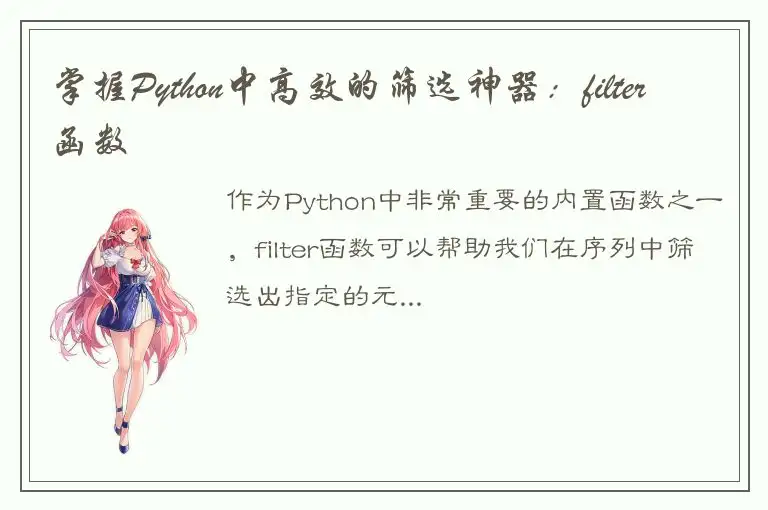作为Python中非常重要的内置函数之一,filter函数可以帮助我们在序列中筛选出指定的元素。在程序开发中,我们经常需要对数据进行过滤和筛选,就需要用到这个神器。

一、filter函数的基本用法
filter函数的基本语法如下:
filter(function, iterable)
其中,function是过滤条件,iterable是要过滤的可迭代对象。
当function为None时,filter函数默认将iterable中的所有元素返回。
但是如果我们给function传递函数名或lambda表达式,就可以根据自己的需求筛选出指定的元素。
下面通过一个简单的例子来演示filter函数的基本用法:
```python
list1 = [1, 2, 3, 4, 5, 6, 7, 8, 9, 10]
def is_even(x):
return x % 2 == 0
result = filter(is_even, list1)
print(list(result))
```
输出结果:
```
[2, 4, 6, 8, 10]
```
以上代码,我们传递了一个名为is_even的函数作为过滤条件,它的功能是判断给定的数是否能被2整除。
我们用filter函数筛选list1中能被2整除的元素,最终得到了一个新的列表[2, 4, 6, 8, 10]。
二、filter函数的高阶用法
除了上述基本用法外,filter函数还有一些高阶用法。
1.使用lambda表达式简化代码
当过滤条件很短的时候,我们可以使用lambda表达式来简化代码。
```python
list1 = [1, 2, 3, 4, 5, 6, 7, 8, 9, 10]
result = filter(lambda x: x % 2 == 0, list1)
print(list(result))
```
输出结果:
```
[2, 4, 6, 8, 10]
```
与之前的例子相同,我们用lambda表达式代替了is_even函数。
2.过滤多个可迭代对象
除了可以过滤单个可迭代对象外,filter函数还可以过滤多个可迭代对象。
```python
list1 = [1, 2, 3, 4, 5, 6, 7, 8, 9, 10]
list2 = [2, 4, 6, 8, 10]
result = filter(lambda x: x in list2, list1)
print(list(result))
```
输出结果:
```
[2, 4, 6, 8, 10]
```
以上代码,我们使用lambda表达式来过滤list1中存在于list2中的元素。
3.从字典中过滤元素
与可迭代对象类似,我们还可以从字典中过滤元素。
```python
dict1 = {'a': 1, 'b': 2, 'c': 3, 'd': 4, 'e': 5}
keys = ['a', 'c', 'e']
result = filter(lambda x: x[0] in keys, dict1.items())
print(dict(result))
```
输出结果:
```
{'a': 1, 'c': 3, 'e': 5}
```
以上代码,我们筛选了dict1中键为'a'、'c'、'e'的元素。
三、总结
filter函数在Python中是一个非常实用的筛选神器,它可以帮助我们在序列和字典中快速筛选出指定的元素。
无论是在程序开发中还是日常数据处理中,都可以借助filter函数来提高效率,让我们的代码更加简化、优雅。




 QQ客服专员
QQ客服专员 电话客服专员
电话客服专员